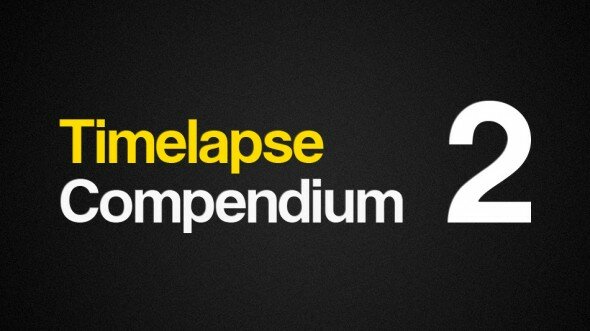This chapter covers the basic theory as well as practical guidelines for shooting timelapse and avoiding common pitfalls.


This chapter covers the basic theory needed to understand and consciously start shooting timelapse and avoid most common pitfalls that might cause frustrations.
Seriously thinking about shooting timelapse it is rewarding to understand the shutter angle concept and use it purposely. If you’re a cinematographer you probably know it, so you may skip this section. Otherwise – keep reading.
In the traditional cinematography, the cine film on the camera is transported between each of frames. After it is moved to a new frame, the shutter is released. Contrary to DSLR cameras, the cine cameras are equipped with a rotary disc shutter and you may control how much it is opened.
In theory, the shutter may be opened from 0° do 360°. The primary reason for controlling shutter angle is deciding on the amount of motion blur appearing on shots which is a function of shutter angle.
Assuming that the camera filming speed is 24 fps, the exposure time of each of frames 1/24s or shorter.
What are the practical implications of all this? As said previously, the primary reason for controlling shutter angle is deciding on the amount of motion blur appearing on shots which is a function of shutter angle. The traditional cinematography makes use of a ‘normal’ 180° shutter angle and we’re used to that amount of motion blur. THe shutter opened to 360° will cause the motion to appear blurry and 15° shutter will cause the image to be sharper, but motion will appear much choppier.
Read more about the shutter angle on wikipedia.
Shutter angle has a significant impact on how your timelapse seequences look like. It should be used purposely and consciously adjusting it depending on the results we expect. In simple words we need to decide on the relative exposure time (RET)
You can shoot 1/125s every minute or you can shoot almost 1 minute exposures every minute.
Shoothing static timelapses (where the camera remains static) we don’t have that serious limitations and we can choose almost any RET. using the RET around 50% (equals 180° shutter angle) wou’ll get a natural-looking results. RET of about 100% will give you blurry motion. However if you intend to shoot motion-controlled timelapse, where the camera is moving between shots and you have a close objects in the foreground you need to pay attention to setting up the apriopriate RET. From my experience you shouldn’t get under RET of 33% because the motion will appear choppy. A 50% – 100 RET will give you good-looking motion and natural results.
Another problem encountered by a timelapse beginner is a flicker. It is mainly related to the DSLR cameras and there are 2 main reasons causing timelapse movie to flicker.
If you’re shooting on auto or semi-auto settings and the exposure is controlled by the camera it is likely to happen that there will occur flicker caused by inaccurate measurement of the light by the camera. Of course if you shoot photos they pass unnoticed, but when you put a number of frames on next to each other you’ll see the negative flicker effect.
In case you purposely want to use automatic modes, I strongly recommend to set the single-point light metering at such point that will be more less unchanging in your frame. If you’re about to shoot a sunset set the metering point to a nearby tree or a part of the ground – it will reflect only the real changes of ambient light. And you’ll avoid the flicker caused by evaluative metering of the entire frame or single-point metering on flowing clouds.
Of course if you can afford switching to full manual mode, this cause of flicker will be eliminated.
The second reason of flicker is an inaccurate work of iris when using the automatic lenses. Normally, the most of DSLRs uses totally open iris during the metering and it is closed just for the moment of exposure. Right after the exposure the iris opens again. The issue is that an iris set to F/11 never stops down exaclty to F/11. Again, the inaccuracy won’t affect single shots, but will cause flicker on timelapse sequences. How to avoid that?
You’re familiar with the basics and know how to avoid common pitfalls. Probably you cant wait to start shooting. The next question arises: what exposure time use?
Generally it all depends on your lenses, camera, ISO used and the subject, but the general guidelines shown below might be useful and repurposed for your particular case giving a good starting point.
12.5x – 75x realtime, so the frame interval set to about 0.5s – 3s. You’ll get the motion of walking people, traffic. In order not to have to blurry motion use 90° – 180° shutter angle (RET 25% – 50%).
100x – 500x realtime, so the frame interval set to about 4s – 20s. I use mostly 5s – 15s intervals when shooting daytime clouds or landscapes so I get a decent speed up and at the same time a 20s timelapse sequence won’t last forever to be taken. Use the shutter angle of 180° – 270° (RET 50%-75%).
Night shots where you want to capture the revolution of the sky or faint details of the Milky Way will require much longer exposure times and much higher ISO. The maximum exposure time that needs to be used to avoid star trails depends on the focal elngth used and region of the sky you shoot. The closer to the north/south pole you are and the wider is lens, the longer exposure time might be used to get the pinpoint stars.
I use mainly 15-30s exposure time, RET of a 100% (360° shutter angle) and high ISO (even 3200 on a 5D MKII). Use as wide angle lens as possible and as fast as possible. On the other hand to achieve great results capturing the night sky you’ll need the highest class lenses. I own a 20mm 1.8 sigma, but it is useless for this purpose because it has so awful comma and astigmatism, that the stars are far from being sharp and pinpoint. They become a curved lines or crosses instead. In order to get at least moderate results I need to stop down to F/4 and that reduces the amount of light captured over 4 times.
Wielkie dzieki za to wprowadzenie w temat.Przymierzam sie do timelapse i ten tekst na pewno zaoszczedzi mi wielu frustracji i nerwow.Bardzo ciekawa strona.Bede wpadal czesciej.
Dzięki za komentarz, zapraszam! Jeśli masz pytania – pisz. Postaram się pomóc i odpowiedzieć.
Znakomite kompendium wiedzy na ten temat – najlepsze jakie do tej pory znalazłem w sieci. Dzięki was zainteresowałem się tym tematem i mam już pierwsze efekty. Z niecierpliwością czekam na nakręcenie filmu w Tatrach. Pozdrawiam i życzę wielu sukcesów.
Wielkie brawa dla autora zarówno za to co tworzy, jaki i za wyczerpujące wprowadzenie w tą technikę. Kompendium na pewno pomoże mi w postawieniu pierwszych kroków w timelapse, zaoszczedzając wielu rozczarowań. Będę sledził rozwój strony .
Dziękuję! Zapraszam w przyszłości!
Could you be more specific when you talk about “the hidden 5D options”? Are these available on the 7D too? Where in the menu exactly can you get to them.
Great guide but the English is a bit broken and sometimes I would appreciate more detail on how to do the things you explain.
Looking forward to your response!
Matt, by “Hidden 5D Options” I refer to Live View settings in one of the yellow menus of the camera. You have a few options there – live view can be set to “stills only”, “stills + movie” and depending on this setting you have also the 2nd menu with a few options. I don’t have my camera with me at the moment and can’t recall these exactly, but there is one setting that causes the iris is closed do target value all the time (so you don’t have to press shutter button halfway to close it).
Can you be more specific about broken English? I’d love to correct my mistakes.